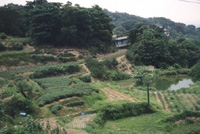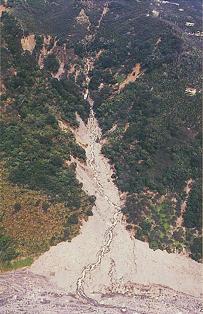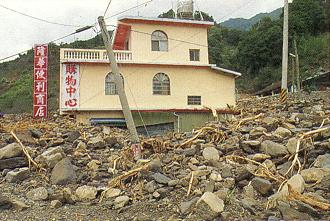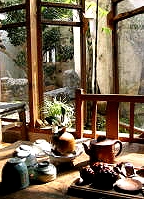






|
TED
Case Studies Number 761, December, 2004 |
Formosa
Oolong Tea : Deforestation, Geographic
Indication
by Mei-Ling
Chen |
|
|---|
 |
 |
 |
 |
 |
 |
 |

1. The Issue
Improved on stander green tea from Fujian in People's Republic of China (PRC), Formosa Oolong Tea is one of the world・s finest teas and a high-economic plant in Taiwan. The production of top quality oolong tea is very labor-intensive but low crop in quantity. However, Formosa oolong tea becomes one of top agricultural production in exporting of Taiwan , planting oolong tea in high elevation has resulted in serious environmental damage . Moreover, to become the member of the WTO and advance economic development, Taiwan government tries to encourage planters to increase the quantity will incur more significant problems.
2. Description
A . Historical Implication
For Taiwanese people, tea is a kind of daily drinks with long history (over 5,000 years), as coffee to people in the West. A famous Chinese saying identifies the seven basic daily necessities as fuel, rice, oil, salt, soy sauce, vinegar, and tea. Historically, the Chinese were the first to discover the tea leaf, and have drunk tea for uncounted ages. During the mid-Tang Dynasty (618-907 A.D.), a man named Yu Lu entered the Buddhist monkhood early in life, but returned when older to secular life. (TECO) He was later best known for summarizing the knowledge and experience of his predecessors and contemporaries into the first compendium in the world on tea - the Tea Classic ( Ch'a Ching). (TECO) Henceforth, tea would play a significant role in Chinese life and spread to the neighbors nearby with Chinese expansion. Even today, the neighboring countries such as Korea, Japan, and Southeast Asia have come to adopt the tea drinking custom for years.
B . The Oolong Tea Industry in Taiwan: Deforestation
| Oolong tea results in not only economic benefits but also environmental damages. In Taiwan, the government has selected Formosa Oolong tea as one of the top agricultural production in exporting (COA) but did not solve that planting of oolong tea harms the environment a lot due to only being planted in high elevation and over-planting resulted from government・s encouragement. Especially during typhoons・ period, June to September, mudflows and landslides caused by over-planting always threaten people・s lives yearly. |  |
C. Geograohic Indication Issue
With similar climate and topography, the wolds and in subtropical zone, Formosa Oolong tea has competed with Oolong tea of Fujian (called Wu-yi tea later) for decades. However, Formosa Oolong tea has taken the lead with better quality recently.
Oolong tea comes in three degrees of fermentation: lightly fermented, moderately fermented, and fully fermented. The identifying features of moderately fermented Oolong teas, such as Formosa Oolong , are with full aroma, clarity, and a golden color. Economically, Taiwan's black teas (fully-fermented teas and moderately-fermented teas, ex. Oolong tea) and green teas have been produced primarily for its export value; tea exports accounted for 75% ~ 85% of Taiwan's tea production. (COA) However, Taiwan tea industry has undergone sweeping changes from export market to the domestic consumption on Paochong tea and Oolong tea over the past two decades. The ratio of tea exports to production has decreased to 15 ~ 20%. (COA) Green and black teas are subject to particularly strong international price competition due to the recent rapid development of Taiwan's industrial sector and a large concomitant increase in labor wages.
D. Formosa Oolong Tea in culture
Today, Formosa oolong tea is widely sold in grocery stores, supermarkets, and Asian stores, such as Ten Ren Group . The famous one is Iced Bubble Tea, a manufactured tea, which is sweet and varied in flavors with low prices. (TenRen) In Taiwan, new style "tea art houses" with elegant, classical interiors have quickly become a common sight around the island. Each local area also holds its own tea-tasting competitions, attracting the participation of large numbers of tea farmers, tea merchants, and tea connoisseurs. Even throughout the Internet, consumers can order oolong tea directly with paying via credit cards. As an imported production with higher price than others, oolong tea is still the top merchandise in "tea world".
3. Related Cases
Thailog-- This case also concerns the issue of environmental problems, such as deforestation. For years, Thailand had long been a traditional exporter of raw logs but simultaneously experienced the highest deforestation rates in the world.
Teak-- The main arguments of this case focus on environmental topics and the hard teak trade between Thailand and Myanmar.
Orange-- Within developing countries, Brazil encounters a difficult situation which is to compete in the world economy or to end underage labor.
Eelfarm-- This case discusses the Eel farming in Taiwan, its importance in Taiwanese fishery exports, and also results in serious environmental problems.
Lesotho--
A contradiction between national economic development and environmental protection.
The Republic of South Africa (RSA) utilizes water from Lesotho and at the same
time, Lesotho establishs many dams for providing water resource.
4. Author and Date
December, 2004
5. Discourse and Status: Agreement
and Complete
Those agreements of WTO about Formosa
Oolong tea's exports, imports, and related regulations are complete. For example,
the WTO Committee on Agriculture, dated 15 September 2004, is circulated at
the request of the Delegation of the Separate Customs Territory of Taiwan, Penghu,
Kinmen and Matsu. The notification concerns 1) the volume-based special safeguard;
2) the market access includes the Separate Customs Territory of Taiwan, Penghu,
Kinmen and Matsu, and 3) the notification under Article 5 of the Agreement is
volume-based special safeguard, and price-based special safeguard. Another dispute
on the issue, additionally, was happened on 18, August 2004. The draft establishes
the pesticide MRLs for 2, 4-D on 1) asparaguses, cherries, cranberries and grapes;
2) azoxystrobin on peaches and cherries; 3) clofentezine on peaches, nectarines,
cherries and almonds; 4) glyphosate on soybeans, corn, wheat, potatoes, asparagus,
almonds and peppers; 5) trifluralin on leaf vegetables with wrapped leaves,
sugarcane, rice, citrus, tea, dry beans, carrots, asparagus, peas, and 6) beans,
leaf vegetables with small leaves and fruit vegetables. (World
Trade Organization)
6. Forum and Scope: WTO and Multilateral
WTO: G/SPS/N/TPKM/42: case on The Separate Customs Territory of Taiwan, Penghu, Kinmen and Matsu
ISO 3720:1986: black tea-- definition and basic requirements
ISO 7513:1990: instant tea in solid form-- determination of moisture content, loss in mass at 103 degrees C
ISO 11286:2004: tea-- classification of grades by particle size analysis
7. Decision Breadth:
The potential impact of the case influences Formosa Oolong teas' farmers and related merchants, both in Taiwan and China.
8. Legal Standing: Treaty
|
9. Geographic Locations a. Geographic Domain: Asia b. Geographic Site: East Asia c. Geographic Impact: Republic of China (Taiwan) As Taiwan:enters; the WTO and is similar to PRC in agricultural productions, the issue of Geographic Indications (GIs) will become the main argument across the Taiwan Strait (between Taiwan and China) in the future. 10. Sub-National Factors: No 11. Type of Habitat: Tropical |
 |
12. Type of Measure: Import Ban
In U.S., Federal Tea Tasters Repeal Act repeals the Tea Importation Act of 1897 to eliminate the board of tea experts and user fees for FDA・s testing of all imported tea . Tea itself is still regulated by FDA. In China, Taiwan tea is almost trade-free with strict trade limitations even Taiwan is also the member of WTO.
13. Direct v. Indirect Impacts: Direct
When Taiwan entered the WTO in 2000, the current taxes of WTO in some fully and partially oxidized teas are up to 25%, but black teas (fully oxidized tea, ex. oolong tea) and green teas (non-oxidized tea) remain 20%. In addition, Taiwan tea has no especial quota within international trade, including WTO and European Union (EU). Moreover, EU has no tariff or especial measure on Taiwan tea・s imports, except organic teas.
14. Relation of Trade Measure to Environmental Impact
a. Directly Related to Product: Yes
b. Indirectly Related to Product: No
c. Not Related to Product: No
d. Related to Process: Yes
15. Trade Product Identification: Tea
Tea is a special product in international trade. In the Third World countries, it is generally produced and treated as a crop, major sector in the agricultural industry, and a heritage from colonial economy. For example, In Taiwan, tea is categorized as an agricultural product in Corp Products category and had been the major export merchandise since the 18th century to the 1950s. However, in U.S. or other consuming countries, it is classified as one of the beverages and put in the category with coffee, including all sorts of teas.
16. Economic Data
The current data shows that tea is no longer the export-oriented product and less like a crop even though the Taiwanese authority still puts it in the same category. The total amount of tea from 1994-2004 indicates that the imports are about 2.3 times of exports, but in the meantime, the values of imports are only 0.77 times of exports. Obviously, the people in Taiwan are consuming more and more foreign-low-price tea and the Taiwan tea has focused on the middle to high value market. The unit price of Taiwan imports is 1.26 while the unit price of exports is 3.959. (the Customhouse of the Republic of China) Taiwan imported many low value tea and exported high value tea.
The numbers of major consuming markets of Taiwan tea reveal the same pattern. The export amounts and values to US and Japan maintain stable level except some particular years (e.g. 1996-1997 to US). The imports from US have gradually increased, years by year. In terms of Japan, the import condition is the same as the U.S. The quantity of exports to Japan has declined since 1997 but the values still keep in a high standard. In sum, the .Taiwan tea・ business has become a high value, import-oriented, and focusing on local market as many reports concluded. (the Customhouse of the Republic of China)
Taiwan tea may be treated as a relative high quality and high price product in the world tea market and seems hard to compete with low price producers such as Vietnam and has to face the big competition from developed countries in the local markets.
17. Impact of Trade Restriction: Low
Generally speaking, Taiwan tea imports into EU only need the ordinary standard such as production ingredients. However, organic teas from Taiwan (and also China; especially, China tea gets much pressure than Taiwan tea because of its quality, such as the use of insecticides) became sparse since EU increased measure standards to 120 items in 2000.
Tea industry was high protected before. After joining the WTO in 2000, Taiwan
reduced the import tax to 25% and will be down to 17% in the future (plans in
2007). The only exception is Chinese tea. By invoking the special exclusive
protection of WTO, Taiwan rejects any Chinese agricultural products including
tea. Also, Taiwan tea is hard to market in China because Taiwan tea is always
in high price with high quality but low quantity. It will be a problem in Taiwan
tea・s international trade and marketing in the future.
18. Industry Sector: Agricultural Production
19. Exporters and Importers:
(Top 1 to 10) |
Exporters |
Importers |
1 |
Japan |
Vietnam |
2 |
Guam |
Sri Lanka |
3 |
the United States |
Indonesia |
4 |
Hong Kong |
Thailand |
5 |
Singapore |
Singapore |
6 |
Germany |
the United States |
7 |
the United Kingdom |
India |
8 |
North Mariana Islands |
Japan |
9 |
Republic of Korea |
the United Kingdom |
10 |
Canada |
Argentina |
(Resource:
the Customhouse of the Republic of China)
20. Environmental Problem Type:
| According to the data of Taiwanese Government, mudflows and landslides (the soil and water conservation loss) caused by disasters affect agricultural loss directly; some of these disasters are natural, but most of them are due to deforestation, the artificial disaster. |
 |
 |
Take 1999 for example, it is the year with the highest loss of agricultural production, being compared to other years. Generally speaking, the chief reason is :921 Earthquake ,; which is the most serious earthquake with thousands of people・s death, injury and property damage, mostly in Nan-Tou and Tai-Chung County of Taiwan. As the top agriculture in Nan-Tou County, tea・s production is inflicted heavy loss in 1999. |
21. Name, Type, and Diversity of Species
Name: Tea
Type: Formosa Oolong tea
Diversity: White-tip Oolong tea (or called "Pom-Fong" tea), High-mountain Oolong tea
22. Resource Impact and Effect: Low
The environmental problems, such as deforestation, related to the Formosa Oolong tea industry have a low impact on the case presented. To compete with Chinese Oolong teas' production is more important than environmental issues for Taiwan.
23. Urgency and Lifetime: Low and 20 years
24. Substitutes: other teas
25. Culture: Yes
 |
|
Tea is one of beverage products in Taiwan, and taste preferences of consumers do not appear to be same. The natural environment is suitable or tea cultivation and production in many regions of Taiwan, especially Nan-Tou County, the only one county does not sit beside the ocean. Through few past decades, special aromas and flavors of Taiwan's various teas have been produced, including Paochong, Tung-ding Oolong and Formosa Oolong teas. For less environmental damages, Taiwanese government should make proper policies to protect environment, and farmers・ life; at the same time, the government should encourage Oolong tea・s production under such policies.
26. Trans-Boundary Issues: No
27. Rights: No
28. Literature
A. Relevant Literature:
Taiwan Tea Experiment Station, www.tea.coa.gov.tw/eindex.htm
Good sources on Formosa Oolong Tea, general information and official statistics: Taiwan Provincial Government, www.tpg.gov.tw; for English text version, click here
Stash Tea, Formosa Oolong Fancy Grade, www.stashtea.com/w-111004.htm
Taipei Economic & Cultural Office in the U.S. (TECO), www.houstoncul.org/default_backup.htm
FoodChina.com; it is a good gateway
to Agri-China information, www.foodchina.com.tw/content/shownews.asp?newsid=11965
Council of Agriculture, Executive Yuan, R.O.C (COA), eng.coa.gov.tw
Wang, Yi-Feng, :The transmigration
of environmental damage,; This Week in Taiwan. The article is available
at www.newtaiwan.com.tw/news.asp?Serial=01200409103425&Class=%E5%90%8D%E5%AE%B6%E5%B0%88%E6%AC%84
TenRen Group, the famous Oolong tea
retail company, www.tenren.com.tw;
for English text version, click
here
World Trade Organization, www.wto.org,
and WTO documents, docsonline.wto.org/GEN_searchResult.asp
International Organization for Standardization,
www.iso.org/iso
A good source for teas' international
trade, Tea and Coffee Trade Journal, www.teaandcoffee.net/index.html
U.S. Food and Drugs Administration,
www.fda.gov/default.htm; other
American official department, including U.S. Department of Commerce: Bureau
of the Census, www.commerce.gov, and
International Trade Administration, www.ita.doc.gov
The World Trade Organization, www.wto.org
For more 921 Earthquake information, www.archives.gov.tw/921,
provided by Taiwanese Government
B. Image Credits:
Taiwan Tea Experiment Station, www.tea.coa.gov.tw/eindex.htm
Such as Golden Moon Tea, shop.store.yahoo.com/goldenmoon/
Stash Tea, Formosa Oolong Fancy Grade, www.stashtea.com/w-111004.htm
TenRen Group, www.tenren.com.tw
Journal of Earth Science, earth.fg.tp.edu.tw/ learn/esf/magazine
12 /2004
Please contact Meiling at mc6521a@american.edu